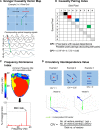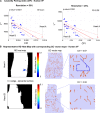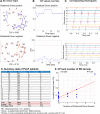Granger Causality-Based Analysis for Classification of Fibrillation Mechanisms and Localization of Rotational Drivers
- PMID: 32064900
- PMCID: PMC7069398
- DOI: 10.1161/CIRCEP.119.008237
Granger Causality-Based Analysis for Classification of Fibrillation Mechanisms and Localization of Rotational Drivers
Abstract
Background: The mechanisms sustaining myocardial fibrillation remain disputed, partly due to a lack of mapping tools that can accurately identify the mechanism with low spatial resolution clinical recordings. Granger causality (GC) analysis, an econometric tool for quantifying causal relationships between complex time-series, was developed as a novel fibrillation mapping tool and adapted to low spatial resolution sequentially acquired data.
Methods: Ventricular fibrillation (VF) optical mapping was performed in Langendorff-perfused Sprague-Dawley rat hearts (n=18), where novel algorithms were developed using GC-based analysis to (1) quantify causal dependence of neighboring signals and plot GC vectors, (2) quantify global organization with the causality pairing index, a measure of neighboring causal signal pairs, and (3) localize rotational drivers (RDs) by quantifying the circular interdependence of neighboring signals with the circular interdependence value. GC-based mapping tools were optimized for low spatial resolution from downsampled optical mapping data, validated against high-resolution phase analysis and further tested in previous VF optical mapping recordings of coronary perfused donor heart left ventricular wedge preparations (n=12), and adapted for sequentially acquired intracardiac electrograms during human persistent atrial fibrillation mapping (n=16).
Results: Global VF organization quantified by causality pairing index showed a negative correlation at progressively lower resolutions (50% resolution: P=0.006, R2=0.38, 12.5% resolution, P=0.004, R2=0.41) with a phase analysis derived measure of disorganization, locations occupied by phase singularities. In organized VF with high causality pairing index values, GC vector mapping characterized dominant propagating patterns and localized stable RDs, with the circular interdependence value showing a significant difference in driver versus nondriver regions (0.91±0.05 versus 0.35±0.06, P=0.0002). These findings were further confirmed in human VF. In persistent atrial fibrillation, a positive correlation was found between the causality pairing index and presence of stable RDs (P=0.0005,R2=0.56). Fifty percent of patients had RDs, with a low incidence of 0.9±0.3 RDs per patient.
Conclusions: GC-based fibrillation analysis can measure global fibrillation organization, characterize dominant propagating patterns, and map RDs using low spatial resolution sequentially acquired data.
Keywords: algorithm; atrial fibrillation; catheter ablation; incidence; ventricular fibrillation.
Figures








Comment in
-
Response by Handa et al to Letter Regarding Article, "Granger Causality-Based Analysis for Classification of Fibrillation Mechanisms and Localization of Rotational Drivers".Circ Arrhythm Electrophysiol. 2020 Aug;13(8):e008951. doi: 10.1161/CIRCEP.120.008951. Epub 2020 Aug 18. Circ Arrhythm Electrophysiol. 2020. PMID: 32809880 Free PMC article. No abstract available.
-
Letter by Masè et al Regarding Article, "Granger Causality-Based Analysis for Classification of Fibrillation Mechanisms and Localization of Rotational Drivers".Circ Arrhythm Electrophysiol. 2020 Aug;13(8):e008675. doi: 10.1161/CIRCEP.120.008675. Epub 2020 Aug 18. Circ Arrhythm Electrophysiol. 2020. PMID: 32809881 No abstract available.
References
-
- Gutbrod SR, Walton R, Gilbert S, Meillet V, Jaïs P, Hocini M, Haïssaguerre M, Dubois R, Bernus O, Efimov IR. Quantification of the transmural dynamics of atrial fibrillation by simultaneous endocardial and epicardial optical mapping in an acute sheep model. Circ Arrhythm Electrophysiol. 2015;8:456–465. doi: 10.1161/CIRCEP.114.002545. - PMC - PubMed
-
- Hansen BJ, Zhao J, Li N, Zolotarev A, Zakharkin S, Wang Y, Atwal J, Kalyanasundaram A, Abudulwahed SH, Helfrich KM, et al. Human atrial fibrillation drivers resolved with integrated functional and structural imaging to benefit clinical mapping. JACC Clin Electrophysiol. 2018;4:1501–1515. doi: 10.1016/j.jacep.2018.08.024. - PMC - PubMed
-
- Calkins H, Hindricks G, Cappato R, Kim YH, Saad EB, Aguinaga L, Akar JG, Badhwar V, Brugada J, Camm J, et al. 2017 HRS/EHRA/ECAS/APHRS/SOLAECE expert consensus statement on catheter and surgical ablation of atrial fibrillation: executive summary. Europace. 2018;20:157–208. doi: 10.1093/europace/eux275. - PMC - PubMed
Publication types
MeSH terms
Grants and funding
LinkOut - more resources
Full Text Sources
Medical
Miscellaneous

